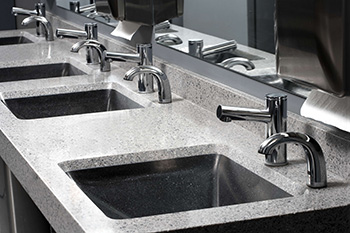Green Restroom Design Promotes Hospital Efficiency
 Infection control, safety concerns and operational efficiency are key drivers of todays restroom design in health care facilities. Industry research and statistics underscore the growing importance of these priorities all of which have direct impacts on patients, staff, visitors and administration. By focusing on innovative design, high-quality fixtures and steadfast maintenance practices, health care facilities will find health-promoting and cost-saving opportunities that will optimize restroom operations.
Infection control, safety concerns and operational efficiency are key drivers of todays restroom design in health care facilities. Industry research and statistics underscore the growing importance of these priorities all of which have direct impacts on patients, staff, visitors and administration. By focusing on innovative design, high-quality fixtures and steadfast maintenance practices, health care facilities will find health-promoting and cost-saving opportunities that will optimize restroom operations.
Water Woes
Maintaining hospitals and health care facilities requires significant water and energy use. The water used in hospitals and other health care facilities represents 7 percent of the total water use in commercial and institutional facilities in the U.S., according to WaterSense, a partnership program with the Environmental Protection Agency. Depending on size, location and other factors, water use in health care facilities can range from 68,750 to 298,013 gallons per year per bed.
Restrooms are blamed for much of the burden. Domestic and restroom uses of water account for 35 percent of hospitals overall consumption of water beating out all other end-use categories, such as heating and cooling.
Hospital facility managers can benefit from environmental and efficiency standpoints by auditing water usage, making operational improvements and upgrading plumbing fixtures. A team of plumbers that specialize in hot water installation in Brisbane are also going to install a hot water system into the hospital restrooms.
Low-flow, water-conserving fixtures have become the standard in commercial restrooms. For example, while high-efficiency toilets use less water to flush waste, dual-flush toilets conserve water by using different amounts of water for various flushing needs. Most models use 1.6 gallons per flush (GPF) for solid waste and 0.8 gallons for liquid waste. This ensures that water isn’t wasted, as restrooms are using only what they need to. Some commercial companies even look to services similar to Robinsons Facilities Services (https://www.robinsonsfs.com) to help ensure that commercial facilities are equipped for repairs and inspections if needed, ensuring that they are able to save water.
For even greater water savings, ultra-low flow toilets and waterless urinals may be used, while sensor-activated flush meters are an option for controlling water use at peak times. The facility has been showing interest in changing to this new water-saving measure for some time, seeking the aid of a local plumbing service (visit now for more information). In addition to this, the plan may include tankless water heaters instead of the traditional water heater. Tankless water heaters concealed within the pedestal of lavatory systems are another way to increase efficiency. Much like your home, you’ll need to have a hot water tank to drive up efficiency, for more information, you may want to check out the Hot Water Heater Expansion Tank How They Work & Do You Need One. These tankless units to heat only the amount of hot water needed for each use, which eliminates wasting electricity to heat an entire hot water tank for restrooms.
Better Hygiene, Better Health
The CDC estimates that hospital patients in the United States acquire about 722,000 infections each year, which is equivalent to approximately one infection for every 25 patients. Germs that reside in restrooms exacerbate the situation, as a 2011 study at the University of Florida College of Medicine in Gainesville found that restrooms in three health care facilities yielded seven bugs that are responsible for two-thirds of healthcare-associated infections (HAIs).
Restroom design using updated and attractive hand-washing fixtures in addition to keeping a clean and well-maintained restroom environment can go a long way in helping to promote good hand hygiene by patients, staff and visitors.
Durable & Sustainable
Fixtures made of durable, natural and recycled materials are growing in popularity. One new example is a molded natural quartz material that can be sculpted into a range of design options and shapes. Composed of an eco-friendly resin made of soy and corn, natural quartz is Greenguard certified, virtually maintenance-free and doesnt require sealing or buffing. Its smooth, seamless finish also has a non-porous surface so it does not support microbial growth.
Hands-Free Fixtures
Touching conventional faucet handles, even after washing, recontaminates just-cleaned hands. Sensor-operated faucets, flush valves, soap dispensers and hand dryers help minimize touchpoints (faucet handles, door latches and damp areas) on germ-ridden restroom surfaces and reduce cross-contamination.
High-speed touchless hand dryers also promote hand drying with hygienic benefits but without excess paper waste, expense and extra maintenance. Newer models are also highly energy efficient, as they use 80 percent less electricity than older hand dryers, while drying hands in as little as 10 to 12 seconds.
Solid Surface
Lavatories made from smooth, non-porous solid surface material can help guard against dirt buildup, and the growth of mold or bacteria. Solid surface fixtures also feature an integrated bowl design that eliminates cracks and crevices in which microbes can hide and further helps prevent the spread of germs.
No matter what equipment is being specified for a hospitals or health care facilitys restroom, its essential to select high-quality durable restroom furnishings. Higher-quality washroom fixtures made of durable materials have hygienic qualities, are more resistant to wear and tear, and can significantly reduce upkeep and maintenance so staff can focus on other duties. While promoting hand-washing practices, these fixtures also save money on labor, materials and repairs costs over time.
Will Haas is product manager for Menomonee Falls, Wis.-based Bradley Corporation, a USGBC member and manufacturer of locker room products, plumbing fixtures, washroom accessories, partitions and emergency fixtures.
